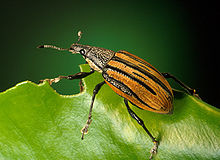- Diaprepes abbreviatus
-
Diaprepes abbreviatus 
Scientific classification Kingdom: Animalia Phylum: Arthropoda Class: Insecta Order: Coleoptera Family: Curculionidae Genus: Diaprepes Species: D. abbreviatus Binomial name Diaprepes abbreviatus
Linnaeus, 1758Synonyms Curculio abbreviatus Linnaeus (basionym)
Diaprepes abbreviatus is a species of weevil that is native to the Caribbean[1], where in Spanish it is colloquially called chichí. It is an agricultural pest in several Caribbean countries. In 1964 this weevil was accidentally introduced in the US state of Florida where it is at present a major pest of citrus. It was first discovered in southern California in 2005, where it is a pest of citrus, avocado, and nursery stock.[2] It is also known to infest sugarcane, tuber-bearing crops such as potatoes, and ornamental plants. Common names for the insect include diaprepes root weevil, citrus root weevil and sugarcane rootstock borer weevil.
The adult citrus root weevil is somewhat variable in size but just over 1 cm (0.39 in) in length on average. Its elytra are glossy black with large stripes of tiny yellowish-orange scales, and its head and legs are black. It has adhesive pads on its legs which confer the ability to adhere to very smooth surfaces. The larva is a plump pale grub with a dark head, up to 2.5 cm (0.98 in) in length. A female weevil might lay 5,000 eggs, depositing them in clusters on leaves, then folding and gluing the leaves together. After a week the larvae emerge from the eggs, fall to the ground, and burrow down to the roots of the host plant. They feed on the roots for several months, which is very damaging to the plant. While the adult weevil does feed on the foliage of the plant, it is the larvae that do the most damage. They often eat the taproot of the plant, which can kill it by depriving it of water and nutrients or by making it vulnerable to infection by fungi, or water moulds such as Phytophthora. The weevil spreads mainly by "hitchhiking" when infested plants, soil, and containers are moved from site to site.[2]
A variety of agents are being studied as possible biological pest control for the weevil, including ants, parasitic wasps, at least one virus, and Bacillus thuringiensis. The nematode Steinernema riobravis is released in irrigation water in infested fields in Florida to combat the pest.[2] The weevil is difficult to control because each female produces so many offspring.
References
- ^ Weissling, Thomas J.; Jorge E. Peña; Robin M. Giblin-Davis; Joseph L. Knapp, Jr.. "Diaprepes Root Weevil, Diaprepes abbreviatus (Linnaeus) (Insecta: Coleoptera: Curculionidae)". Electronic Data Information Source. University of Florida IFAS Extension. http://edis.ifas.ufl.edu/in151. Retrieved 2010-07-09.
- ^ a b c Jetter, K. M. and K. Godfrey. (2009). Diaprepes root weevil, a new California pest, will raise costs for pest control and trigger quarantines. California Agriculture 63:3 121-6.
External links
Categories:- Entiminae
- Animals described in 1758
- Insects of the Caribbean
- Agricultural pest insects
Wikimedia Foundation. 2010.
